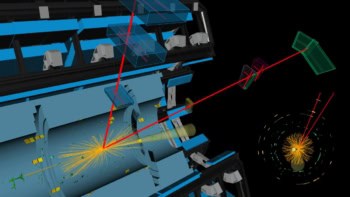New measurements of the magnetic moment of the muon are set to re-ignite the debate over the Standard Model, which has successfully explained the results of particle physics experiments for over 30 years. Twice as precise as the previous best measurements, the latest results support the idea that ‘new’ physics exists beyond the Standard Model. The findings were announced today at a special colloquium at Brookhaven National Laboratory in the US.
The Standard Model describes how quarks and leptons – a class of particles that includes electrons, muons and neutrinos – interact. Since all quarks and leptons have an intrinsic angular momentum or ‘spin’, they also have a magnetic moment, which is related to the spin by the ‘g-factor’. Simple quantum theories predict that g = 2 for both the electron and the muon.
But these calculations do not include ‘radiative corrections’ – the continuous emission and re-absorption of short-lived ‘virtual particles’ by the electron or muon. These corrections make the g-factor sensitive to the existence of other particles – both established particles such as electrons and photons, and other, as yet undiscovered, particles that are not part of the Standard Model.
In February 2001, the Muon (g-2) Collaboration based at Brookhaven reported measurements of the magnetic moment of the muon that it claimed could not be explained by the Standard Model. The group was 99% confident in its result, but later that year physicists in France found an algebraic error in the calculations that reduced this certainty to 87%.
Now these doubts could be dispelled. “While not definitive, this new result is consistent with the presence of effects which are outside the Standard Model. Further work to clarify this hint is essential, nevertheless this result is very interesting and provocative,” says Lee Roberts, a spokesman for the g-2 experiment.
The new results will also be reported at the 31st International Conference on High Energy Physics in Amsterdam, and the collaboration has submitted a paper to Physical Review Letters.



